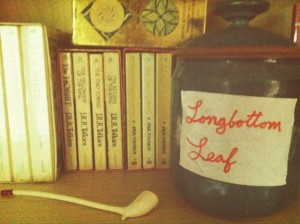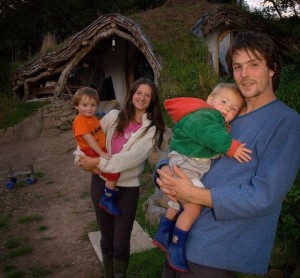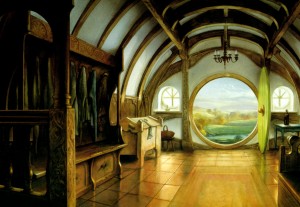The paperback of The Wisdom of the Shire is available on October 29th from St. Martin’s Griffin. It includes a bonus chapter called “The Children of the Shire.” Here’s Chapter 1 of the book that has been translated into eight languages including Spanish, Italian, French, Portuguese, and Finnish.
Chapter 1
HOW SNUG IS YOUR HOBBIT-HOLE?
Throughout my life I’ve often heard people describe a snug home or a particularly cozy room as being “just like a Hobbit-hole.” This is one of the highest compliments a Tolkien fan can give, for it’s the sort of place where they’d want to spend some serious leisure time—to read a book or have a conversation, to eat a delicious meal or just sit and think.
On the very first page of The Hobbit Tolkien introduced the world to Bilbo Baggins (and Middle-earth for that matter) with a lengthy and loving description of a Hobbit-hole. His Halflings are, without a doubt, creatures of comfort. But they don’t live in ostentatious mansions or castles of stone. Their cozy homes, built into the sides of hills for optimal insulation, are cheery wood-paneled refuges with fireplaces, well-stocked pantries, featherbeds and pretty gardens right outside their deep-set windows.
Peter Jackson’s film adaptations show Bag End in all its oak paneled and glowing hearth fire glory. Who wouldn’t want to inhabit that welcoming house with its hand-hewn beams, big round front door and cozy sun-dappled kitchen? The fact that you’re reading this book means you’re most likely smiling wistfully right now thinking, I would live there faster than you can say “Drogo Baggins’s boat!”
In The Hobbit, when Bilbo is trapped inside the Elven-king’s palace—existing as an invisible and lonely thief without a bed to call his own—he wishes he were back in his dear home, sitting by the fireplace with a shining lamp on his table. To him this is the height of comfort. Warmth. Light. Peace of mind. We must remember that Bilbo rushed out of his home in such a hurry to join Thorin Oakenshield and his band of Dwarves that he’d forgotten to bring a pocket-handkerchief!
 When I was a boy I tried to turn my drab suburban bedroom into my own private Hobbit-hole. I found an old wingback chair at the local thrift shop—a chair suitable for marathon sessions of The Lord of the Rings. I stacked my shelves with Tolkien books I’d rescued from used-bookstores. I started a secondhand pipe collection (assuring my mom they were “Just for show!”) and bought some cheap drugstore pipe tobacco called “Borkum Riff,” placing it in a big jar I labeled Longbottom Leaf. Every time I opened the lid it filled my room with a scent redolent (at least I thought) of Bag End. This room was my refuge, even though it probably reeked like the back of a union hall.
When I was a boy I tried to turn my drab suburban bedroom into my own private Hobbit-hole. I found an old wingback chair at the local thrift shop—a chair suitable for marathon sessions of The Lord of the Rings. I stacked my shelves with Tolkien books I’d rescued from used-bookstores. I started a secondhand pipe collection (assuring my mom they were “Just for show!”) and bought some cheap drugstore pipe tobacco called “Borkum Riff,” placing it in a big jar I labeled Longbottom Leaf. Every time I opened the lid it filled my room with a scent redolent (at least I thought) of Bag End. This room was my refuge, even though it probably reeked like the back of a union hall.
Over the years I’ve found I was not alone in my earnest longing for a Hobbit-hole to call my own. This notion, however absurd, appeals to many of us Shire enthusiasts. Some people have managed to create their own versions of Bag End, like Simon Dale in the United Kingdom who built an abode worthy of Hobbiton. The house, half-buried in the Welsh countryside, was entirely fashioned by hand out of local materials such as stones and wood from surrounding forests. It has a roof that collects water for the garden and an air-cooled fridge.
 (Simon Dale and family, Wales)
(Simon Dale and family, Wales)
There are very few places throughout the various Halflings’ adventures that offer a facsimile of the extreme comforts of the Shire home: the magical Rivendell with its whispering trees, soft beds, wistful Elves and Lays of the Elder Days Poetry Nights; Tom Bombadil’s cottage nestled in the woods near the gurgling Withywindle River, complete with chef Goldberry—ravishing daughter of the River-king; and Beorn’s wooden hall with its endless supply of honey cakes, mead and waitstaff of trained bipedal animals.
All of these locations have something in common, despite their curious inhabitants. Like Hobbit-holes they’re safe, warm, comfortable and filled with good food. They’re homey places to rest and regenerate before a long journey, and they’re connected to the natural world in a way that makes them almost part of the surroundings.
Modern homes are a sharp contrast to the cheery Hobbit-holes and have become repositories for cheap imported junk that we toss out like so much rubbish after a few short years of use. For many of us our connection to the world outside our homes is what we see from our cars in bumper-to-bumper traffic on the way to hermetically sealed office buildings. Urban sprawl or “Orc-ification” is turning our cities and towns into vast and ugly corporate retail outlets.
Everything inside and outside a Hobbit-hole would have been made by hand. And it would all have been created to last a lifetime, from the brass knob in the center of the big round front door, to the clay mugs in the kitchen, to the chair in front of the fire. When did we all become so helpless that we stopped learning how to make or fix the simplest things? Why don’t we expect the same sort of permanence and quality in our own lives?
 (Fisher Blacksmithing handcrafted garden tools)
(Fisher Blacksmithing handcrafted garden tools)
There are ways to change. Internet sites like Makezine.com show people all over the globe making remarkable utilitarian objects by hand, and Instructables.com will teach you the step-by-step process of how to build and mend things you would have thought were impossible. Online retailers like Etsy allow hundreds of thousands of craftspeople from all across the world to sell their handmade items (everything from furniture to clothes to ironmongery) to millions of buyers. These artisans are making amazing things out of recycled products as well as upcycled materials.
Seventy years ago Tolkien lamented how machines seemed to be taking over the world. Everywhere he looked trees were being cut down to make way for ugly garages, gasworks and factories. (Imagine how he would feel about the state of things now.) He wrote most of The Lord of the Rings during WWII at his house in Oxford while thunderous warplanes roared overhead flying off to Europe. He mused grimly that Moloch, a god that sacrificed its firstborn sons, must have taken over as ruler of the world.
Tolkien wrote often to his son Christopher (his chief audience for his stories) who was serving in the Royal Air Force at the time, sending him chapters of The Lord of the Rings as soon as he could get copies typed up. In his letters he described to his son the little joys of life back in Oxford. He also told him about the simple trials and tribulations of being a homeowner. Reading about the mundane, when you’re far from home, is sometimes just as interesting as hearing about the sublime.
Tolkien had seen the horrors of mechanized war firsthand, having served in the trenches of WWI in France. Like the Hobbits in The Lord of the Rings, he’d returned from the desolation of the battlefield to a changed world—a world where all but one of his friends no longer walked the Earth. Ten years after the Great War he was staring at a blank page of paper when the opening lines of The Hobbit popped into his head.
And thus was born the first Hobbit—the reluctant hero who departs his beloved abode and returns from a great adventure a changed man. We’d all be lucky in life if we had the chance to experience an unexpected adventure, and then make our way back safely to a place of comfort. Sometimes the only way we can appreciate our home and the simple happiness it has to offer is to be away from it for a while.
After the battle of the Pelennor Fields, when Merry is recovering in Gondor’s Houses of Healing from his brave attack on the dread Witch-king of Angmar, he tells Pippin that one thing alone has sustained him through the hardships of his terrible journey: the deep spiritual roots he’s put down in his beloved Shire.
This is Merry’s Hobbit-hole of the mind.
Try to think of a place in your own life that was like a Hobbit-hole. It could have been your beloved grandparents’ living room, or a kindly music teacher’s studio or a good friend’s comfy apartment. What was it about that place that made you feel at home? That allowed you to dream? Was it the space itself, or the people in it? Or a combination of both? At some point in your life your subconscious put down “roots” in this place, and you can take strength from this memory, even if the actual place no longer exists.
You can create a snug “Hobbit-hole” wherever you are—in your office, in a hotel room, in a college dormitory, in an apartment in the city or a bedroom in the suburbs. Because the space which you inhabit is irrelevant compared to the power of your mind to project contentment. For me that contentment has always meant having a good book at hand, so that no matter where I was stuck physically, my mind was free to soar.
 In the final scene of The Lord of the Rings, Sam Gamgee returns from the Grey Havens to Bag End, arriving at night. He’s just said good-bye to Frodo forever and he is terribly sad. But then he sees the cheery yellow glow of firelight emanating from the house that now belongs to him—a home bequeathed to him by Frodo. The house itself—the structure—is not important, however. It’s what’s inside: his loving wife and daughter waiting for him with a warm meal on the table.
In the final scene of The Lord of the Rings, Sam Gamgee returns from the Grey Havens to Bag End, arriving at night. He’s just said good-bye to Frodo forever and he is terribly sad. But then he sees the cheery yellow glow of firelight emanating from the house that now belongs to him—a home bequeathed to him by Frodo. The house itself—the structure—is not important, however. It’s what’s inside: his loving wife and daughter waiting for him with a warm meal on the table.
It’s a beautiful bookend to Tolkien’s beloved novels: The Hobbit starts at Bag End with a callow bachelor and The Lord of the Rings ends there with a wise father. All of Tolkien’s great adventures are set in between the opening and closing of the door to a simple and yet miraculous dwelling called a Hobbit-hole.
The Wisdom of the Shire Tells Us …
“Your true home is inside your heart and stays with you wherever you go; but a nice snug room is a lovely thing to come back home to!”
Pre-order the paperback of The Wisdom of the Shire now from Amazon and receive it October 29th.
Copyright © 2012 by Noble Smith



Speak Your Mind